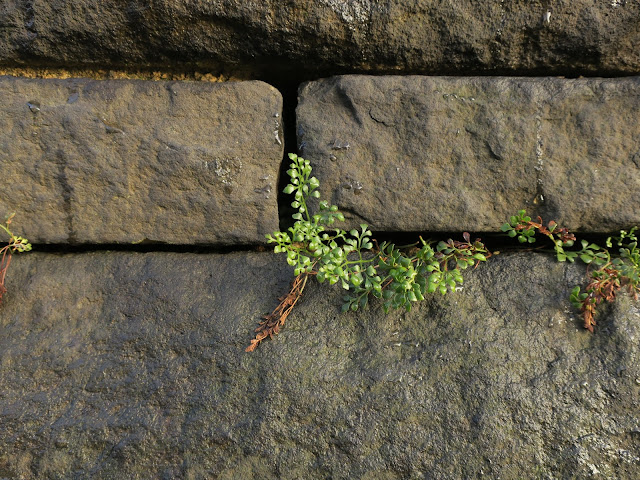I was expecting to say it was pointless planting onions in the autumn. If I'd left them in their bags they might have grown more. And while other people are talking about their little daffodils emerging there's not a sign that I've buried any anywhere. And as for shallots; they they appear to be rotting instead of growing.
I've hardly visited the allotment since before Christmas. The ground froze and I fell. Then there was snow. Now, the soil is squishy where snow-melt has been topped up with rain. But the non-growing onions, now visible, are entertaining.
The onion above is progressing somewhat. But others are doing their own thing. To its right there's one with its roots up instead of down. How is this? Did I inadvertently put it in the wrong way? I might have done but don't think so.
The picture above shows how such annoying miracles are taking place. Onions are pushing themselves out of the soil and flopping about. The one on the left has lurched sideways but its roots are still in the ground; the middle one is in entirely the wrong place - plucked by a bird from further along the row and dropped here. As for the one on the right - you can clearly see the hole it has got itself out of. Its roots are still healthy and it's sprouting at the top so I tipped it gently back into place and hunched earth around it like a scarf. To the right of the right-hand onion is the footprint of a passing creature.
One of the striking differences between where I live now and more or less anywhere else I've ever lived is the absence of dogs and cats. I suppose it's because houses in my neighbourhood tend to be small and hardly any have gardens. A pleasant result is that there is hardly any dog poo on the pavements. In the summer I will be able to take deep breaths on summer's days and delight either in the scent of fresh air or of traffic fumes instead of being knocked out and disappointed by the stench of pet-excrement which is the downside of living by a well walked path beside the sea. Other allotmenteers tell me cats do come by but I doubt they cause much trouble because, judging by the streets, they are few, which is good. Dogs on the loose might crash into you, muddy pawed, but cats are less random. Whenever you plant a plant, that's where they'll choose to sit. Wherever you sow some seeds, that's where they'll dig. Turn your back on a seed tray and a spare cat will be settled in in a shot and pretend it's been there all morning. But here . . . few dogs . . . few cats . . Bliss. But badgers?
There's something about the smell of disturbed earth. In the autumn, I put bulbs in one day and they were gone by morning.
This is where I planted ornamental aliums. And this is also where they got dug up again. I'm leaving the hole. I've filled it in three times. What's the point? And I don't want to draw attention to there being any bulbs still there. The smell of disturbed earth might work like a huge speech bubble saying 'hey, you forgot these'.
Above is where I planted carrots. (The markers show the end of rows.) But they didn't grow. I'm trying to remember whether I then planted something in the intervening slots to make up for them. Small daffodils? Shall I tug out the grass seedlings or will this attract creatures to the aliums nearby?

Still . . . the compost bin is happy. One thing is going well! In the photo fresh new veg. has been added. A friend has given it a cabbage. (I would have chopped it up a bit but a gift is a gift.) Around the outside I've built a barricade of large stones and a bank of turfs. The stones are to keep the bin from blowing over and to keep out rats, the turfs are to keep worms warm. It seems to be working. No further rat disturbance and what's specially gratifying - no smell of rotting veg. You can stick your head right into the bin and breathe deeply and still think it's a pleasant day. It's not got far yet. The actual compost is only about six inches deep. But I don't think it's doing too badly for a newly established bin in winter.
So . . . back to the start . . . was it pointless to plant onion sets in the autumn? No. They may not have advanced but if they weren't there I wouldn't have been paying such careful attention to the earth around them.
The red leaf belongs to a plant which will spread if I leave it there - with a huge network of red roots - I know because I pulled masses out last year.
And horse-tails. See them?
Which means as well as easing the onions back into their slots, and taking others back to where they belong, I'll be removing the brilliant little plants which, if left in place, will overwhelm them.
(Amongst other things.)


































